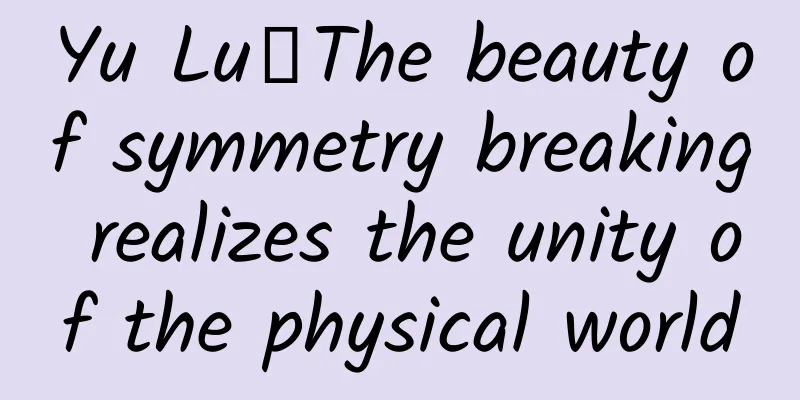Yu Lu丨The beauty of symmetry breaking realizes the unity of the physical world

|
Where is the beauty in broken symmetry? It actually has a very profound physical meaning. But the more important thing is, It achieves the unification of the physical world. Yu Lu, Academician of the Chinese Academy of Sciences Science experts talk about science | Beijing 2021 Hello everyone, I am Yu Lu. The issue I want to discuss today is symmetry and its breaking. Everyone knows what symmetry is, and we all pursue the beauty of symmetry. Symmetry breaking refers to the reduction of symmetrical elements: from very symmetrical to not very symmetrical, and then to completely asymmetrical. How does this breaking come about? What is the beauty of it? This is what I want to discuss today. This is Chinese folk paper-cutting. The images are very beautiful. One of the important reasons why they are popular among the people is that their patterns are symmetrical. Symmetry is also a very important element in both Chinese and Western architecture. This is the central axis of the Forbidden City in Beijing. This is a picture of the nave of a Western Gothic church. This shows that culturally, people like symmetry. There are even more symmetrical elements in nature. For example, beautiful butterflies are bilaterally symmetrical. The above picture shows some of the patterns of ice crystals we have selected. They form very beautiful, highly symmetrical wafers and grains. The ice we usually see is just ice cubes, and we don't see such beautiful ice crystals. If you want to see these beautiful ice crystals, you have to go to the suburbs in early spring. They are next to the small streams in the mountains. Is absolute symmetry the most beautiful? Completed: 10% ////////// Since symmetry is so good, is perfect symmetry the best? To discuss this issue, I would like to cite an analogy between science and art. Many famous scientists, such as Mr. Tsung-Dao Lee, have emphasized the analogy and connection between science and art. He established a center for advanced research in China. This center was of course established as a scientific institution, but it also attached great importance to the combination of science and art. Poetry, painting, sculpture, music and other works of art are all created by artists. Artists express their inspiration and what they observe through artistic means, which can mobilize the audience's potential emotions. The better and more profound the artist's ability to mobilize emotions, the more audiences the artwork will have, and the wider and more lasting it will be in time and space. Science is the study of natural phenomena, including physics, chemistry, astronomy, geology, biology and other disciplines. However, science itself is the creation of scientists and the laws they have summarized. The simpler, clearer and more profound the law, the greater its impact will be, and the wider and more lasting its application will be. So science and art have a lot in common. They are both the crystallization of human wisdom, and they both pursue beauty and universality. ▲ Artworks also value symmetry, but not "complete" or "absolute" symmetry Look, this is a painting by Mr. Wu Guanzhong, a famous Chinese painter. At first glance, this painting depicts a tree by the water and its shadow. But if you look closely, are the tree and its shadow completely symmetrical? No. The slopes on both sides of the ridge of the mountain behind it are not completely symmetrical either. In fact, complete and absolute symmetry is not the most beautiful. This painting was created by Mr. Wu Guanzhong after many communications with Mr. Tsung-Dao Lee. It can show what physicists mean by symmetry breaking. Let's look at a more prominent example. Mr. Tsung-Dao Lee's book includes paintings by Hongren, a famous Chinese painter from the Ming and Qing dynasties. Mr. Hongren was the founder of the Chinese geometric landscape painting school. The left picture is his original painting. The right picture is a painting made by following the middle line of the left picture and inverting its right side to the left to make the left and right sides completely symmetrical. The beauty of the painting made by artificial inversion is much less. So this is a revelation to us: art is about symmetry, but this symmetry is not absolute or complete. Symmetry breaking in parity violation Completed: 20% ////////// In physics, the most famous and influential example of symmetry and its breaking is the violation of parity conservation proposed by Mr. Yang Zhenning and Mr. Li Zhengdao in 1956. ▲ Chen Ning Yang (1922-) and Tsung-Dao Lee (1926-) What is parity? Parity is an inversion operation. If after an inversion it is still itself, it means it has even parity; if after an inversion it becomes negative, it means it has odd parity. Paper cutting is the best example of inversion. Paper cutting is done by folding paper, then cutting along the fold, and then letting the paper go. It is naturally completely symmetrical. Of course, if you fold it again, this paper cutting will have four groups of symmetry, up and down, left and right. Mr. Tsung-Dao Lee once pointed out that symmetry is not only static, but more importantly, it is a dynamic process. So the symmetry breaking of parity that we are going to talk about today is not a simple breaking of an image, but its process. As time evolves, is this process the same? Let me first talk about some simple basic knowledge. There are many forces in the macroscopic world. The most familiar one is the attraction or repulsion between electric charges or magnetic moments, which is called electromagnetic interaction. Electromagnetic force and gravity can be seen in the macroscopic world, but there are two other forces that can only be seen in the microscopic world, which is at the quark level. These two forces are strong force and weak force. The strong force is the interaction between protons and neutrons or quarks; the force between electrons and leptons is the weak force. Radiotherapy requires a cobalt-60 radiation source, which emits electrons, and this process is a weak process. In 1956, when studying some problems of elementary particles, Mr. Yang Zhenning and Mr. Li Zhengdao discovered a phenomenon: there are two kinds of particles that look the same, but the unstable particles will decay in the end, and the decay process is different. Many people have put forward various opinions on this. These two gentlemen are innovators in science. They raised an innovative question: Is it possible that parity is not conserved in weak interactions? They carefully reviewed all the literature and found that there was no experimental evidence that parity was conserved in weak interactions. They also theoretically proposed five different methods to verify that parity is not conserved. ▲ Wu Jianxiong (1912-1997) In the same year, the famous Chinese physicist Chien-Shiung Wu directly verified the violation of parity conservation at very low temperatures using cobalt 60. This experiment was very difficult because it combined nuclear physics experiments with low-temperature experiments. The publication of Wu Jianxiong's experimental results proved that the predictions of Yang and Li were correct. Therefore, in 1957, the second year after their article was published, they won the Nobel Prize in Physics. It is very rare in the history of the Nobel Prize that a discovery made in the first year was awarded the Nobel Prize in the second year. This work is groundbreaking and opened a new era. Phase transition and symmetry breaking Completed: 30% ////////// We know that under normal pressure, water will boil at 100 degrees and freeze at 0 degrees. Boiling and freezing is a phase change process. So what do phase transitions have to do with symmetry? Steam or water has a property called translational invariance, which means that if it moves along a plane, it remains the same, but ice is different. Ice looks like a smooth piece, but if you use a microscope or X-ray it, you will find that ice is composed of lattices. The image on the right is an image of the actual structure of ice crystals. If you want to move ice, you must move a lattice, so the original translation invariance is broken. Water evaporation and water freezing are just one example, and there are actually many examples around us. Next, we will introduce the ferromagnetic phase transition and Curie point. In fact, our ancestors were the first to discover ferromagnetism, which was the compass, one of the four great inventions of China. The left picture is the image of the compass at that time, and the right picture is the horseshoe-shaped magnet that we are familiar with in our daily life. What is magnetism? For example, iron atoms have a small spin or a small magnetic moment, which is ferromagnetism. The magnetic moments or small spins are all arranged in the same direction, which is called ferromagnetism or magnetic order. ▲ Ferromagnetic phase transition - Curie point If the temperature is raised, the ferromagnetism will become less and less, and the direction of the small magnetic moment will not be completely parallel. When the temperature rises to the Curie point, the small magnetic moment will be completely disordered, the magnetism of the ferromagnet will be lost, and it will become a paramagnet. This is a classic example. In fact, the phase transition phenomenon is more common in the microscopic world. The laws followed by microscopic particles are different from the Newtonian mechanics we are familiar with. These particles themselves have dual natures, they are both particles and waves. ▲ The wave-particle duality of light The wave nature of light means that, since light is a wave, if light is allowed to pass through a narrow slit and then through two narrow slits, and then an object that can detect light is placed at the back, interference will occur. The most obvious evidence of the particle nature of light is the photoelectric effect, which means that electrons escape when light is shone on the surface of some metals. ▲ The wave-particle duality of electrons Electrons have the same property. After the electron beam passes through two narrow slits, this interference pattern can also be seen behind the narrow slits. This is called electron diffraction. The most obvious evidence of the particle nature of electrons is the reverse effect of the photoelectric effect. The picture on the right shows the X-ray invented by German scientist Roentgen in the late 19th century. X-rays have extremely strong penetrating power and extremely short wavelengths, and are widely used in medicine. Bose-Einstein condensation and symmetry breaking Completed: 40% ////////// So, how can we use a simple image to illustrate the duality of particles in the microscopic world? In microscopic quantum theory, particles have no concept of trajectory, so they cannot be tracked, making it impossible to distinguish which is particle A and which is particle B. From this, it can be deduced that microscopic particles are also called identical particles, and they are indistinguishable. In the 1920s, it was discovered that the properties of particles are related to their spin, which is the origin of ferromagnetism. ▲ Quantum statistics - particles are indistinguishable There are two types of spin. One is called a boson. If the spin is an integer such as 0, 1, or 2, it is called a boson. It can accommodate many particles in the same state. Photons are a type of boson. The other is called a fermion, and its spin is a half-integer, such as the spin of an electron is 1/2. Each state of a fermion can only accommodate one particle. ▲ Bose-Einstein Condensation (BEC) Bosons can undergo Bose-Einstein condensation, such as the superfluidity of liquid helium. Helium is the last gas to be liquefied, and it does not become liquid until it is within 4 degrees of absolute zero. ▲ Pyotr L.Kapitza and 4He superfluidity The person who discovered this amazing phenomenon was Peter Kapitsa, a famous physicist from the former Soviet Union. He found that if helium is placed in a container and a very small, very fine capillary hole is opened at the mouth of the container, it will spray upward like a fountain of pressurized water. This is the fountain effect in liquid helium. ▲ Superfluidity of liquid helium This picture is also very interesting: put the superfluid liquid helium in a hanging basin, and the liquid helium will flow out along the wall of the basin. Look carefully, the liquid helium is constantly dripping down. Is superconductivity a Bose condensation phenomenon? Completed: 50% ////////// There are similar phenomena in electrons. In metals and alloys, we observe superconductivity. What is superconductivity? ▲ Zero resistance One is the complete lack of resistance. After liquefying helium, Kammerlingh Onnes discovered that mercury's resistance suddenly disappears when it is cooled to a certain temperature. If we bring a magnet close to a conductor loop, the magnet will induce an electric current in it. Normally, when the magnet is removed, the current in the conductor will decay quickly, but if it is a superconductor, in principle or ideally, it will never decay. This property is called persistent current. ▲ Completely anti-magnetic Meissner effect Superconductors have another wonderful property: they are completely anti-magnetic. Ferromagnetic materials concentrate all magnetic lines of force on themselves, while superconductors do the opposite, and expel all magnetic lines of force. The picture on the right is a prototype of a superconducting maglev train. If you put a magnet on a superconductor, it will always float in the air. This is called complete anti-magnetism. ▲ Order parameter If we want to describe phase transition, we need to introduce an order parameter. Phase transition can be divided into two categories, one is the first phase transition with a jump in the middle, and the other is the continuous phase transition with a continuous change. ▲ Symmetry Breaking One important thing about the description of phase transitions is symmetry breaking. For example, a square has eight symmetry elements. If you turn it into a rectangle, there are only four symmetry elements left. The spin changes from being able to go up or down to only being able to go up or down, which means that there is no symmetry from two symmetry elements to one element. These are discrete symmetries. ▲ Ferromagnet - Rotational symmetry breaking Another kind of symmetry is continuous symmetry. What is continuous symmetry? The circumference of the bottom of a round bowl is symmetrical, but if its temperature is lowered, it is no longer the bottom of a bowl, but becomes the bottom of a wine bottle or a Mexican straw hat. Why? This is because its order parameter itself is not expressed by real numbers but by complex numbers. The real numbers we first learned can be represented by points on the number axis, while complex numbers need to be described by points on the complex plane. There are two axes on the complex plane, which also have directions and can describe continuous symmetries. In fact, people already understood how to describe phase transitions in the 19th century, and had a very simple theory for describing phase transitions, which was later rediscovered many times in different ways and in different fields. ▲ Landau mean field theory Landau, a Soviet scholar, reduced this theory to a very simple image, which is equivalent to a potential function with a potential well, and then an order parameter. You see, if it is above the transition temperature, just like the very smooth bowl I mentioned earlier, when it is below the phase transition point, you will find that it has two bottoms instead of one. In this way, the original left-right symmetry will be broken, and only one will be left. This theory was used for a long time until the 1960s, when precise experimental measurements discovered that some of the precise predictions made by this theory were incorrect. People then developed a new theory: the renormalization group. In the superconductivity phenomenon, there are two most basic phenomena, one of which is zero resistance. ▲ Ordinary conductor This animation demonstrates how electrons in normal metals are disturbed and scattered by various factors as they move. ▲ Superconductor This animation demonstrates the orderly movement of electrons in a superconductor. So the superconductivity phenomenon has to explain two things. The first is why it has no resistance, and the second is why it is completely antimagnetic. ▲ Bardeen realized that the energy gap in the elementary excitation spectrum would lead to the "rigidity" of the wave function The usual current has two terms, one is the paramagnetic term and the other is the diamagnetic term. If the quantum state of the wave function is rigid, it is not easy to have very low energy excitation, the paramagnetic term will disappear, and only the diamagnetic term will remain. This is the London equation. Each state of fermions can only have one electron, and they slowly fill out, and what is finally formed is called the Fermi surface. The electrons in the Fermi surface form a Fermi sphere. If there are two more electrons on the Fermi sphere that have an attractive force, no matter how weak the attraction is, they can form a bound state and can be bound together to become a particle. ▲ Cooper pairing phenomenon Use animation to demonstrate this pairing phenomenon: In the lattice, due to the interaction between electrons and the lattice, two electrons can pair up to form Cooper pairs. This is a very important result. ▲ "Double knots grow wings to become superconductors" Regarding the superconductivity phenomenon, painter Hua Junwu conceived a vivid picture after discussing with Mr. Tsung-Dao Lee: it is very difficult for a single bee to move, but if they are paired together, they can fly freely. Because Cooper pairs are fermions that make up bosons, bosons can condense. But because Cooper pairs are very fat and very large, all Cooper pairs are not separated, but overlap with each other, so this matter is a little more complicated. This wave function was proposed by John Robert Schrieffer, and it is composed of the product and sum of many terms. If each term is to be paired to produce an electron pair, it can only be achieved when the spin direction of one momentum K is downward and the spin direction of the other momentum -K is upward. Although this function solved the superconductivity problem, the number of particles in the wave function is not conserved, and it includes many components, some of which are N, some are N+2, and some are N-2, which is inconsistent with the original framework of physics. So it was not until 15 years later in 1972 that they were awarded the Nobel Prize after the predictions proposed by the BCS theory were experimentally proven. This is a prime example of continuous symmetry breaking. Development of superconductivity theory Completed: 70% ////////// Because the order parameter of superconductivity is a complex number, it has two vibration modes. One is the radial vibration mode, which has an energy gap, i.e., its amplitude. The other vibration mode is the phase rotation angle mode, which is massless. ▲ Symmetry breaking and Goldstone boson Who formally proposed the symmetry breaking of superconductivity, that is, the existence of a real phase? It was proposed by Brian Josephson, a 22-year-old doctoral student at Cambridge University at the time, after being inspired by Anderson's course on symmetry breaking. ▲ Josephson effect There is a tunnel effect in semiconductors. If there are conductors on both sides and an insulating layer in the middle, electrons can pass through after a bias voltage is applied. Tunneling is usually a single electron tunneling effect, but Josephson predicted the tunneling effect of Cooper pairs. This means that Cooper pairs can pass through the "tunnel" two by two without any resistance. When no bias is applied, it can have superconducting current. ▲ PW Anderson Anderson also made a more important contribution. He proposed a new idea through the example of superconductivity, called the Anderson-Higgs mechanism, which is to add a gauge field to the symmetry breaking of superconductivity, which will turn the original massless particles into massed ones. This is a very profound thing. Anderson-Higgs mechanism In superconductors, the gauge field is the Coulomb field. After the superconductor and the Coulomb field are coupled, the massless bosons cannot be observed, and what can be seen are the so-called plasma polaritons. In particle physics, this was proposed by Mr. Higgs, and it is very important. ▲ Weinberg-Salam electroweak unification theory Symmetry breaking in the superconducting mechanism and the Anderson-Higgs mechanism opened a new path for the entire particle physics theory and triggered new breakthroughs. A key step in this process was the Weinberg-Salam model proposed by Steven Weinberg and Abdus Salam in the mid-1960s. This theory was proven by experiments at the European Organization for Nuclear Research in the 1980s. This theory proposed to unify weak interaction and electromagnetic interaction into a unified framework. The Standard Model and the "God" Particle Completed: 80% ////////// Who originally proposed this framework? The theoretical framework of the Weinberg-Salam model is called Yang-Mills field theory, which was proposed by Mr. Yang Zhenning and his postdoctoral fellow Mills in 1954. When this theory was proposed, it was opposed by many people, including Pauli, an authority in theoretical physics, who said that there must be a zero-mass boson in this theory, and this zero-mass boson does not exist in the world. But Mr. Yang still insisted on publishing it. Later developments proved that the entire particle physics theory could indeed be established within Mr. Yang's framework platform. ▲ Standard model The unified theory of weak and electromagnetic forces, after the strong force was later added, became a complete model of elementary particles, namely the standard model. ▲ Standard model You may have heard of quarks and leptons, and there are many interactions between them. The most important thing in the entire microscopic universe is to find a Higgs particle, which is also a boson. ▲ The discovery of the “God” particle All other particles in the standard model have been discovered, but the Higgs particle has not been discovered until 2013 in an experiment at the European Organization for Nuclear Research. This particle, called "God," is the key to whether the entire standard model is correct. With it, the model of elementary particles is established. The beauty of broken symmetry Completed: 90% ////////// ▲ Symmetry breaking: from microscopic to cosmic In addition, building a bridge connecting the microscopic world and the macroscopic world is also inseparable from symmetry breaking. According to existing ideas, the universe began with a big bang, and after the big bang, there was an inflationary period of accelerated expansion in a very short period of time. This inflation was caused by a kind of symmetry breaking. ▲ Age of the Universe In fact, the mass we are familiar with now only accounts for a very small part of the mass of the entire universe, and the vast majority of the rest is dark mass and dark energy. What these dark mass and dark energy are, we have not yet figured out. Having said all this, I want to briefly review what is so beautiful about symmetry breaking? It actually has very profound physical implications, but the more important thing is that it realizes the unification of the physical world, first the unification of the microscopic world, and then the unification of the microscopic world and the macroscopic world. So the beauty of broken symmetry does exist, but one can only truly appreciate and savor it after understanding some things. Thank you everyone! - END - The articles and speeches only represent the author’s views and do not represent the position of the Gezhi Lundao Forum. |
<<: If someone shares these things with you, don't hesitate to report it!
>>: Why can't elephants grow tusks anymore?
Recommend
How to develop a love and marriage mini program? How to develop a love and marriage mini program?
How to develop a love and marriage mini program? ...
Toutiao, Weibo and other 20 new media operation guides
New media operation is a series of operational me...
A detailed explanation of the marketing and promotion methods of Internet finance from 5 cycles!
This article will reveal the underlying logic of ...
Trump's wife tested negative for the new coronavirus, is it true?
According to reports, US President Trump stated a...
16 lessons from Wuwei teacher to learn how to buy at the bottom and sell at the top
Introduction to the 16 lessons of Wuwei teacher o...
Efficient employment class for emotional counselors, achieving a side job with a monthly income of 50,000+ [audio course]
Efficient employment class for emotional counselo...
Should you keep your chopsticks separate? Just look at the bacteria content on your chopsticks!
"Come on, have some of this. You can't r...
Beware! Don't take this common medicine carelessly! Improper use may harm your body, tell your family immediately
Sore throat, runny nose Cold, fever, headache Man...
Does drinking coffee cause osteoporosis? Huaxi doctors summarize the three bad habits that hurt bones the most
When people reach a certain age, it is easy for t...
The most comprehensive summary of operation and promotion channels in history!
I believe this may be the most comprehensive prom...
Does the Zhaoqing Mini Program Mall need to apply for a business license?
Can an e-commerce business license be used to ope...
How to operate and plan an offline event?
I participated in a two-day and one-night offline...
What should a bidder do? Summary of bidding skills
I believe that 90% of the viewers who clicked in ...
The key project of the Chinese Academy of Sciences, "Research on Key Materials for Strategic Emerging Industries", passed the expert acceptance
Recently, the key project of the Chinese Academy ...
Is brewing tea in a thermos cup toxic and carcinogenic? What food safety experts say
"When people reach middle age, they can'...





![[Powerful] D3.js visualizes the number of SSH brute force attacks](/upload/images/67ebedf0d7aa6.webp)



